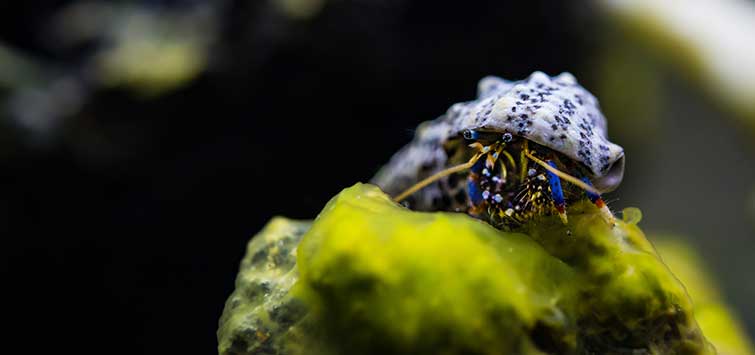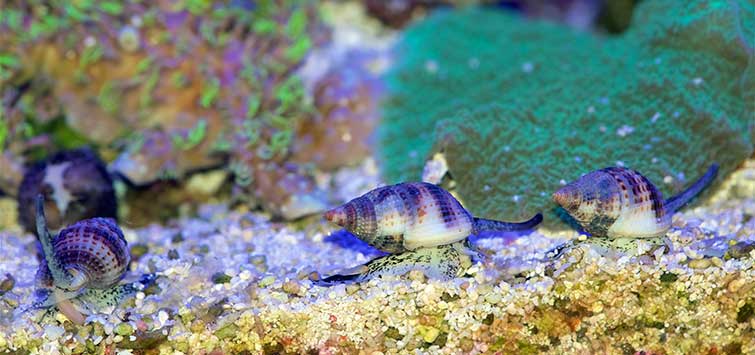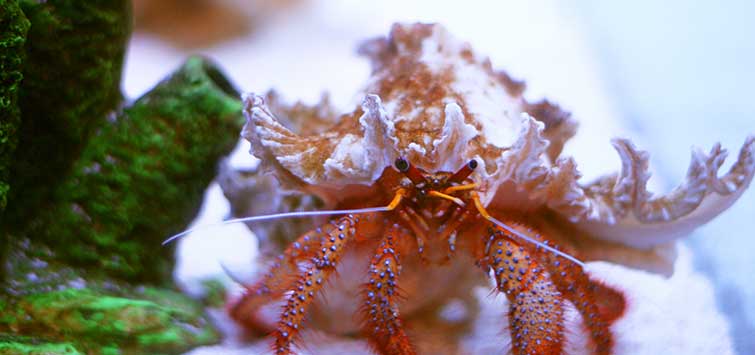Algae Eaters in the Marine Aquarium
Author: James W. Fatherree
The perpetual growth of the unwanted algae in marine aquariums is one of the biggest headaches for hobbyists. It comes in many forms, ranging from an unattractive green film of microalgae on the glass to fleshy, vine-like macroalgae that grows over rockwork and smothers corals. To keep an aquarium looking its best, and sometimes to keep corals alive, algae must be dealt with.
Unfortunately, there is no way to keep algae from growing in the first place. Even with the best filtration and regular water changes, algae will still appear; however, maintaining excellent water quality and keeping waterborne nutrients at the lowest possible concentration will prevent the worst of it.
Algae Eating Invertebrates
The occupants of a tank can also be beneficial in this regard. In addition to numerous fishes that can help keep algal growth in check and an aquarium looking sharp, there are algae-eating creatures that can help out, too, including various crabs, sea urchins, sea slugs, and snails. We’ll take a closer look at these invertebrates here.
Crabs
Many crabs can be kept in aquariums stocked with larger fishes with no problems, but only a few can be housed in reef aquariums without causing trouble. This is because most crabs are carnivores and scavengers, and only a few are algae eaters that tend to leave other animals alone. There are two types of algae-eating crabs that are readily available in the hobby: the Sally Lightfoot crab and the common mithrax crabs.
Sally Lightfoot crabs (Percnon gibbesi), also called spray crabs, remind me a lot of long-legged spiders. The small ones are often sold as algae-eaters and will typically crawl around an aquarium grazing on filamentous (hair) algae. However, these crabs can grow to about 4 inches (10 cm) across and often become increasingly aggressive as they get larger. They also tend to shift from grazer to carnivore over time; in fact, they may attack and eat small fishes and tear up corals to get at any food inside them.
When small, Sally Lightfoot crabs may be suitable for reef aquariums but will likely need to be removed when they grow. At any size, they may also be fine in a non-reef aquarium with fishes large enough to fend for themselves.
The mithrax crabs commonly found in stores tend to stay much smaller and are not likely to cause trouble. They are the emerald crab (Mithraculus sculptus) and the red mithrax crab (M. forceps), both of which reach a full size of about 2 inches (5 cm) across. These are the only creatures I know of that will consistently eat nuisance bubble algae (Ventricaria ventricosa and Valonia spp.), along with other types of fleshy macroalgae, making them particularly desirable. They’ll also eat leftover fish foods.
While these two species are generally safe for both reef and non-reef aquariums, note that there are other mithrax crabs that can get huge and wreak havoc, so make sure you know for sure what type you’re getting.
I’ve kept many of the emerald and red mithrax crabs over the years without incident, except for two that I had to remove. For reasons unknown, one started pulling my hermit crabs out of their shells and eating them. Another started eating some tiny featherduster tube worms.
I’d never heard of either of these things happening before. It’s still a bit of a mystery, but the crabs had been living in the aquariums for at least several months and had cleared out all of the bubble algae—maybe they were just really hungry. I’d still add them to an aquarium without worrying but would keep an eye on them and give them some pellet food or other tidbits if they got aggressive.
Hermit Crabs
Hermit crabs come in many sizes and eat a wide range of foods. Some are aggressive carnivores, some are scavengers, and some are algae eaters, so again, make sure you know what you are getting and choose one of the readily available species of algae eaters that stay relatively small.
The most commonly offered for the job are the blue-legged hermit crab (Clibanarius tricolor), scarlet hermit crab (Paguristes cadenati), blue-knuckle hermit crab (Calcinus laevimanus), and red-leg hermit crab (C. tibicen). They will all eat microalgae and filamentous algae, in addition to leftover fish foods. While I’ve never had any problems with them, it’s worth noting that some hobbyists report that the blue-knuckle and red-leg hermits will occasionally kill a small snail for its shell. Personally, I wouldn’t let that dissuade me from adding any of these to a reef or non-reef aquarium, since I’ve kept scores of them over the years without any issues.
Many hobbyists also say that the commonly available white-spotted hermit crab (Dardanus megistos) and Halloween hermit crab (Ciliopagurus strigatus) are dangerous carnivores that should not be added to a reef aquarium; others would disagree, saying that they’ll eat macroalgae and uneaten fish food, and are at least as safe as many other hermit crabs. They get much larger than the other species mentioned and will climb over everything, but I’ve successfully kept them in reef and non-reef aquariums.
Sea Urchins
Numerous types of urchins are available, and they also come in a range of sizes and have varying diets. Many get rather large and can only be kept in large tanks, but the smaller ones are well suited for life in a typical aquarium. Most urchins will eat algae of some sort, with the most commonly offered species being consumers of both microalgae and filamentous algae.
What I typically see for sale are rock urchins (Echinometra spp.), long-spined urchins (Diadema spp.), and the very popular tuxedo urchin (Mespilia globulus), all of which can be kept in reef and non-reef aquariums.
There are only a couple of cons to mention when it comes to these. First, the long-spined urchins certainly live up to their name, since their spines can get rather large over time. It’s important to be careful when working on an aquarium housing one to avoid a very painful puncture wound (or several). And, unfortunately, all three species can scour nicely colored coralline algae off rocks, carving thin, white zig-zagging trails. But it will grow back, so again, I wouldn’t let this keep me from adding one to an aquarium.
Sea Slugs
For the most part, sea slugs should not be kept in aquariums, as many have very specific diets, which may be a single species of coral in some cases. Others can get enormous, and except for the mammoth specimens, all have a bad habit of getting sucked up into pump/filter intakes.
There is one type that I’ve seen offered from time to time that is the only slug I’ve kept and would keep again if a macroalgae outbreak occurred: the lettuce sea slug (Elysia crispata), from the Caribbean. This species grows to a size of 2 or 3 inches (5 to 7.5 cm) and looks quite fancy. It’s also very interesting because it manages to keep some of the photosynthetic structures (chloroplasts) from the algae it eats and uses them in the same way that corals use algae to get food. They’ll need bright lights to stay alive and should not be kept in non-reef aquariums. Also, they can get sucked up into unscreened intakes and will starve to death in a relatively clean aquarium. Their life span is also pretty short, at several months to about a year, which is something else to keep in mind.
Snails
As with the other invertebrates, there are numerous types of snails with variable diets. Some spend most of their time buried in the sediment, some are strictly scavengers, some are carnivores, and some are algae eaters. Some also stay relatively small, while others get huge and shouldn’t be kept in any home aquarium.
That being said, there are some that stay the perfect size, eat nothing but algae, and don’t cause any problems. So, I’ve saved the best algae eaters for last, with the top picks for reef and non-reef aquariums being the fighting conch (Strombus alatus) and the various turban snails belonging to the genera Turbo, Trochus, and Astraea.
Despite its name, the fighting conch doesn’t get into fights, but it will grow up to 4 inches (10 cm) in length. It will eat microalgae and detritus, but it typically feeds only on the substrate and needs a lot of food. It should only be kept in large aquariums with a lot of exposed sandy space and algae. The fighting conch can, however, be fed algae pellets if there isn’t much to eat on the sand.
The turban snails for sale typically reach a full size of about 1 to 2 inches (2.5 to 5 cm) and can thus be kept in smaller tanks. They’ll also eat microalgae, but unlike the fighting conch, they will crawl all over everything in an aquarium, cleaning up as they go. They don’t damage corals and such, or eat coralline algae. My favorites are the astraea snail (Astraea tecta), which is typically the smallest of the bunch, and the Mexican turbo snail (Turbo fluctuosa), which also stays small at about 1½ inches (4 cm) when fully grown and often feeds on filamentous algae.
Keep Track of Your Invertebrates
About the only thing to be mindful of is having too many invertebrates in an aquarium. Algae eaters need algae, and they may eat only certain types. Make sure to provide enough food and to remove a tank inhabitant before it starves if that becomes an issue.
And, of course, it should go without saying that none of these algae-eating creatures should be kept with any fish that’ll eat them!

.png?h=595&iar=0&w=2781&hash=5FD5E69473BCC22199FBFA2FB71B6033)



